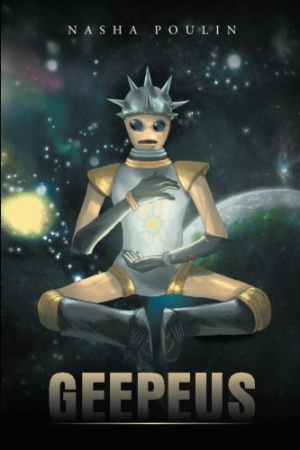Geepeus
Poulin excels at the art of world-building in this sci-fi adventure that journeys everywhere from the future to deep in human history.
Geepeus, by Nasha Poulin, contains classic science fiction tropes such as time and space travel, interactions with extraterrestrial life, and futuristic technologies. The plot is original and takes many thrilling, unexpected turns.
The book follows a young archaeologist as she meets and travels alongside the extraterrestrial life form Geepeus. While on a dig, Jacqueline “Jacky” Michaud and Jeremy “Jim” McBean uncover a strange metallic orb. This discovery provokes a strong reaction from the native inhabitants, who push Jacky and Jim into a crevasse. There, they find an alien spaceship with a strange life form who has been lying dormant inside. Geepeus quickly frees them and takes them into space in order to assist his leader, the Creator, with the complicated task of creating and monitoring the humanoid species. While traveling the galaxy and different time lines, Jacky witnesses the birth of the human race, the demise of the dinosaurs, and learns more about the mysterious alien life forms that manipulate the galaxy.
Jacky, the protagonist, is initially very frightened and overwhelmed by the discovery of Geepeus and the prospect of a space odyssey. However, as she is exposed to and overcomes new challenges along her journey, her self-confidence increases. As Jacky grows more independent and confident, she begins to demand respect for her opinions from those around her, eventually culminating in confrontations with Geepeus and the Creator.
Poulin exhibits knowledge of the art of world-building in Geepeus, as setting and the use of small details are the strongest storytelling elements of the novella. Small observations made by the main character help to develop the technologies of the alien species and the world they live in; for example, “The scene changed to ships working on the atmosphere, gathering dust and debris and bringing them to the new planet, or keeping the debris and bringing it to the mother ship.” The author also explains key historic events through the intervention of aliens: “We can eliminate the inferior beings by asking the new species for offerings. We will make rules and rituals and ask for sacrifices.” With lines like this, Geepeus explains historic events and practices such as human sacrifice, making the possibility of alien intervention in the development of Earth seem much more plausible.
Although physical characteristics and actions are very well described, there are often times when these details become monotonous and difficult to read. For instance, the dialogue describing the ship: “The greenhouse is situated on the fourth deck. … This ship is programmed to keep the plants and insects alive in a dormant state in a comfortable environment.” But the greenhouse is never visited again, making its location and function on the ship irrelevant. The novella also contains many distracting spelling and grammatical errors.
Geepeus could be enjoyable to any casual or hardcore sci-fi buff or a young adult reader.
Reviewed by
Gregory A. Lowe
Disclosure: This article is not an endorsement, but a review. The publisher of this book provided free copies of the book and paid a small fee to have their book reviewed by a professional reviewer. Foreword Reviews and Clarion Reviews make no guarantee that the publisher will receive a positive review. Foreword Magazine, Inc. is disclosing this in accordance with the Federal Trade Commission’s 16 CFR, Part 255.

